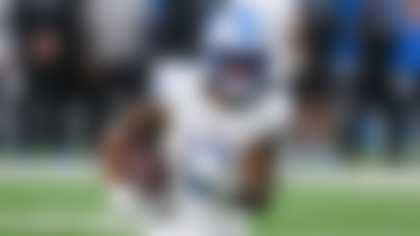Here is the original Top 101 Free Agents list -- courtesy of Gregg Rosenthal and Chris Wesseling -- as it stood before players began to be signed, tagged and/or released:
Due in part to an obsessive work ethic, Cousins has improved every year in the league. His numbers over 48 games since taking over for Robert Griffin III three years ago rival those of Aaron Rodgers during that time span. Quarterbacks of his caliber, durability and commitment level simply don't reach the open market.
Brees benefits from a dynamic ground attack and can't drive the ball like he used to, but he remains one of the most valuable assets in the league at age 39. By all accounts, he's a lead-pipe lock to re-sign with the Saints.
The NFL's premier all-around back of the past four years will likely draw the franchise tag for the second consecutive offseason if he doesn't reach a long-term deal with the Steelers.
Among the leaders in sacks and tackles for loss in a breakout season, Lawrence will enter the 2018 campaign as a 26-year-old building block. The Cowboys have made it clear that he will be tagged if no agreement is reached by the deadline.
Sandwiching an injury-ravaged 2016, Ansah has averaged more than 13 sacks in his last two healthy seasons. Freakishly athletic pass rushers of that magnitude tend to stay put.
One of the league's most dangerous deep threats in 2015, Robinson followed a disappointing 2016 season with a torn ACL in 2017. Suddenly standing in a Super Bowl window, Jacksonville will consider applying the tag to retain Robinson if necessary.
Richardson's Pro Bowl talent may be undeniable, but he's totaled just 2.5 sacks in his past 30 games and will be viewed by many teams as a character risk. He's expected to reach the open market.
On one hand, he's a 24-year-old with obvious talent and No. 1 receiver potential. On the other hand, even a brilliant offensive mind like Sean McVay couldn't bring out that potential last season.
Undrafted out of Ohio State, Norwell has developed into a Pro Bowl-caliber performer in a league that finds it increasingly difficult to field a quality offensive line. With so much capital tied up in Matt Kalil and Trai Turner, the Panthers might have their hands tied with Norwell.
We might be higher on Fuller than most after watching him lead the league in passes defensed last year, per Pro Football Focus. Could he be the next Casey Hayward, making his former team look silly for allowing him to fly the nest after his rookie contract?
Last year, Keenum settled for a $2 million contract in free agency and didn't even crack our Top 101. This time, he has the opportunity to earn life-changing money few journeymen ever see. He's a solid bet to start somewhere in Week 1.
A relative down year and Shakespearean-tragedy ending to his Patriots career in the Super Bowl could keep Butler's price down. Smart teams will pounce, knowing he was a top-10 cornerback in 2015 and '16.
Physical, above-average starting cornerbacks get paid like superstars in free agency. That's why the Rams gave Johnson $30.6 million over the last two years as their franchise player.
Every team could use a player like Joyner, a former cornerback who is comfortable covering the slot, playing the deep part of the field and tackling well at the line of scrimmage. He's like Honey Badger in Arizona, without the cool nickname.
He's either ranked way too high or way too low. With a great combination of smarts, positive game tape and leadership, Bridgewater could have a higher long-term ceiling than even Kirk Cousins. But there's no telling how Teddy will look two years removed from a devastating knee injury.
Like Bridgewater, Bradford is a mystery because of his knee. He put up a quietly-impressive 2016 season and a breathtaking Week 1 performance before he was put on the shelf for nearly the rest of the season.
Breeland is streaky, but few young cornerbacks with his talent get to free agency in their prime.
Solder is virtually the only true starting left tackle available in free agency. He can strike it rich if he wants to leave the Patriots.
Poe showed in Atlanta he could hold up as an every-down player after losing weight and making a consistent impact in the passing game. He's not a star, but he is a starter.
Pugh timed free agency poorly, coming off a season marred by a back injury and playing out of position at tackle. But he's a proven quality guard and those are tough to find.
A talented tease early in his career, Brown has emerged in the last two seasons as one of the league's premier run-stuffing inside linebackers.
There are weeks in which he looks like a tackle-breaking terror with intriguing ability in the passing game. Unfortunately, there might be just as many weeks filled with negative runs, dropped passes and nagging injuries.
Graham is still earning Pro Bowl nods due to his red-zone prowess and name recognition, but it's been four years since he's played at that consistent level.
Billed as a hybrid safety-corner-linebacker early in his career, Vaccaro has never lived up to his potential in New Orleans. Will he find a system that hides his coverage weaknesses and plays to his strengths?
Can Reid continue to play with abandon as a back-end enforcer with concussion concerns, a torn biceps and a PCL sprain on his medical chart?
A run-and-chase linebacker limited to 4-3 systems, Bradham is coming off a career year for the Super Bowl champions.
Although strong against the run, Williamson is a base 3-4 inside linebacker with less-than-ideal coverage skills. Can he be a three-down player?
Burnett has been Green Bay's most consistent performer in the secondary the past two years, but injuries are starting to add up for a player nearing the age-30 barrier.
Lewis is one of the most effective per-play backs in the league, but he's also an undersized injury risk best utilized in space. Will he be another role player exposed outside of New England?
Lotulelei is a dependable starter on the interior, but doesn't make enough impact plays to merit a high-dollar contract.
Thirty years old in May, Davis is coming off two injury-plagued seasons. He was a difference maker the last time he was truly healthy.
A standout early in his career, the 26-year-old missed 12 games in 2017 because of a concussion. He's the best center available on the market.
His disastrous season in Washington doesn't erase the ball skills and after-catch ability he displayed in his 1,000-yard campaign for the Browns. A return to Cleveland looms.
Traded to Buffalo in the Sammy Watkins deal, Gaines completed a rock-solid season as a starter in the Bills' cornerback-friendly defense. He's a capable option for zone defenses.
McCarron was a mixed bag in his four starts in 2015, and there's no telling how he's developed since then. He's likely to be the latest backup quarterback to see his price go up by not playing.
Blocked by Zach Ertz for playing time, Burton excelled when Ertz was out with injury. Burton is the type of high-upside athletic "move" tight end that every team is looking for.
Limited to roughly 1,000 snaps combined over the last two years because of knee injuries, Mewhort was an excellent second-round find at right guard before that.
One of the biggest X-factors in this free agency class, Eifert is among best tight ends in football when healthy. But he's played a total of 24 games in the last four years, including 10 over the last two seasons because of persistent back issues.
He proved in Philadelphia he can produce out of the slot with 225 catches in his first three seasons. He proved in Buffalo he's not talented enough to transcend problematic surroundings.
A favorite sleeper on this list, Jones has position versatility and the ability to take on multiple blockers. He's remained under the radar because he does so much dirty work.
Still good for double-digit sacks in his late 30s, Peppers has reached the stage of a Hall of Fame career where it will prove difficult to lure him away from his hometown Carolina team.
Whitehead has been the best linebacker in Detroit the past two years, which speaks more to the Lions' lack of star power than his own prowess as an above-average starter.
The end could come at any time for a cornerback entering his mid-30s, but Grimes is still playing at a high level as one of the most explosive NFL athletes of the past decade.
The bizarro Marqise Lee, Richardson is a dangerous big-play threat best utilized on downfield routes.
Claiborne might never live up to his No. 6 overall pick pedigree, but he's been a rock-solid starter -- when healthy -- the past two years.
Once christened the "albino tiger" for his rare appearances on the field, Lee has suited up for 30 of Jacksonville's past 32 regular-season games. A flanker with strong catch-and-run abilities, the former USC star isn't much of a deep threat or red-zone weapon.
A backup for three years, Jensen solidified Baltimore's pivot position as a 16-game starter in 2017.
Rent-a-corner keeps supplying league-average starter value on one-year contracts.
The ideal bridge quarterback, McCown is essentially a player-coach at this stage of his career. A red-flag injury risk entering his age-39 season, McCown is perhaps most valuable as a wet nurse for a talented but raw young stallion.
Tailor-made for Sean McDermott's defense, Brown tied for the league-lead in tackles last season. That speaks more to the specious value of tackles as a statistic than Brown's impact as a difference-maker.
For the second time in three seasons, Pro Football Focus' grading system appreciated Sitton more than his own team. That's a red flag, but he can still start at 31 years old.
Like so many intriguing free agents, Brown has a history of injuries that makes him a boom-or-bust option. He hasn't been quite right since his 1,000-yard season in 2015.
McKinnon is the type of "space" player who can excel as a receiver and runner, with his quickness translating to any system.
Ellis was graded as the No. 14 run-stopper among defensive tackles by Pro Football Focus in 2017, and 332-pound nose tackles are hard to find.
Robinson is on this list for the second time in three years after a career-best season covering the slot for the Eagles.
A breakout season on the field and in front of the camera in 2017 should help Boston avoid the type of the low-cost one-year deal he signed last April.
After cleaning up his life as a recovering alcoholic, Seferian-Jenkins looked like a new player with the Jets. (Like the player many expected when the Bucs took him in the second round of the 2014 draft.)
With Andrew Luck, Moncrief looked headed for greatness. Without Luck, Moncrief was blamed for a bad attitude and worse production.
His lightning strike of a six-sack game against Dallas shouldn't overshadow the rest of his disruptive 2017 as a pass rusher.
The quintessential journeyman prior to last season, Melvin emerged as Indy's top cover corner in Vontae Davis' absence.
Colvin was one of the league's most reliable tacklers in the slot, but nobody pays big money for that species.
Davis rehabilitated his value with a strong season in his Big Apple return after a pair of disappointing campaigns in 2015 and '16.
An infamous dinosaur denier, Hayes didn't play like a creature facing extinction at age 32.
One of the most underrated stars of the past decade figures to return to Buffalo for a 13th season. He turns 35 in June.
A true wild card, Easley is a first-round talent with major knee issues and a history of tantalizing play in limited snaps.
Just good enough to be a productive starter for a low-wattage aerial attack.
How much value does Bowman have as a soon-to-be 30-year-old, two-down thumper in a pass-heavy league?
Kline saw a drop-off in effectiveness last season after playing a key role in DeMarco Murray's 2016 bounce-back campaign.
He has a limited skill set, but that skill (speed and big plays) pays. Old buddy Kyle Shanahan could potentially bring Gabriel to San Francisco.
Crowell can be the lead back in a committee attack, but he's nobody's idea of a dynamic playmaker.
Defensive coordinator James Bettcher knew just how to use Branch's ability to cover tight ends. Don't be surprised if Branch follows Bettcher to Big Blue.
Twelve seasons into an incredible career, Ngata still held up well as a role player when healthy in Detroit.
In this market, any sentient offensive lineman is going to find a job. Sullivan, 32, did a nice job as a starter with the Rams.
Murphy followed up a breakout 2016 (nine sacks and 55 total pressures by PFF's count) with a PED suspension and a torn ACL. Not an ideal way to hit free agency.
Inside linebackers who specialize as run-stoppers don't get paid, but Davis is a capable piece to the puzzle.
In this tackle-starved market, the Patriots' fourth-string OT in 2017 will probably get paid after holding up well throughout the playoffs.
"Slot cornerback" is essentially a starting position in today's NFL, evidenced by Carrie's 1,023 snaps in 2017. Carrie is a good one and adds return value, as well.
The run-stopper and former Eagle didn't make a huge impact after settling for a one-year contract last offseason.
Now properly regarded as a clutch playoff performer, Amendola's highest value is to the Patriots. Other teams don't carve out major roles for brittle 32-year-old wideouts who don't moonlight as special teams gunners.
While Kaepernick straddles the line between talented backup quarterback and potential starter, it was crazy to see his talent fall out of the league last season. It will take an ownership group and coaching staff aligned in the decision to bring him in.
Wilson held his own as a starter for a year and a half, but the Lions seemed overly eager to hand his job to converted cornerback Quandre Diggs late last season.
A liability in the passing game, Hill played himself out of a starting job with three years of sluggish football after a strong rookie season. Can he bounce back on a team with a stronger offensive line?
Underwhelming in his Nashville debut, Decker might have left his playmaking ability on the operating table last offseason.
Freeman has been a solid starter when he suits up, but he's coming off a torn pectoral after serving PED suspensions in each of the past two seasons.
Good luck guessing which Martin will show up in 2018. Outplayed by afterthought Peyton Barber and journeyman Jacquizz Rodgers this past season, the 2015 All-Pro stumbled through 2.9 yards per carry for the second straight year.
Plucked off the waiver wire from New England, Ealy held his own in 450 snaps as a rotational lineman with the Jets.
Okafor was one of the pleasant surprises in his New Orleans debut, but he's coming off a November Achilles tear.
Joseph finally showed signs of decline in his age-33 season after 11 years as a Pro Bowl-caliber corner in Cincinnati and Houston.
The Ravens harbored high hopes for Urban as a breakout candidate last season, but he just can't stay healthy.
After hitting 96.7 percent of his kicks in 2017, Gano is a strong candidate for the franchise tag.
Superfluous in Philadelphia after the addition of Jay Ajayi, Blount's a hammer with back-to-back Super Bowl titles to his name.
Johnson held up remarkably well for a 35-year-old coming off a torn Achilles in 2017; he was just overpaid in Kansas City.
Coming off ACL surgery at 34 years old, Sproles wants to play one more season as a scat back and return man.
Slauson gets extra points as a free-agent pickup because of his position flexibility.
A nightmare off the field for much of his career and a major injury risk on it, Galette was effective as a situational pass rusher in 2017.
Kelemete filled in capably as a starter when injuries hit the Saints and could get a chance to start full-time elsewhere.
A well-regarded backup in Pittsburgh with position flexibility, Hubbard performed well as a starting right tackle last season.
Gore can still handle every role a running back is asked to do, even if he's better off in a backup/mentor role. He ran far better than his numbers showed last season.
He probably doesn't want to return as a backup and teams probably shouldn't pay him like a starter. To the booth he goes?











